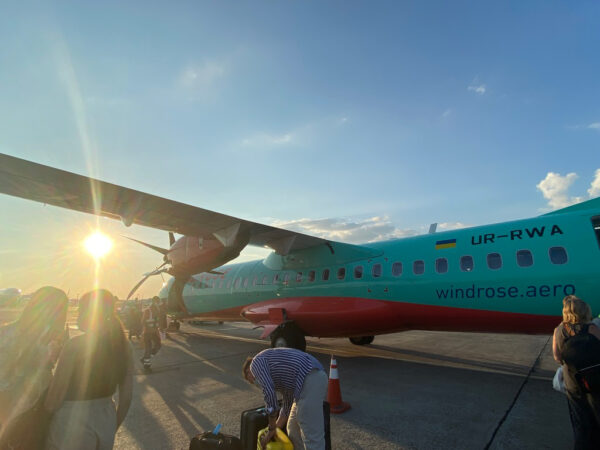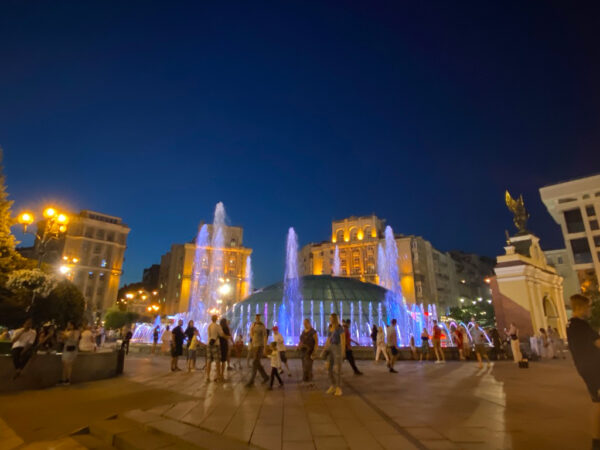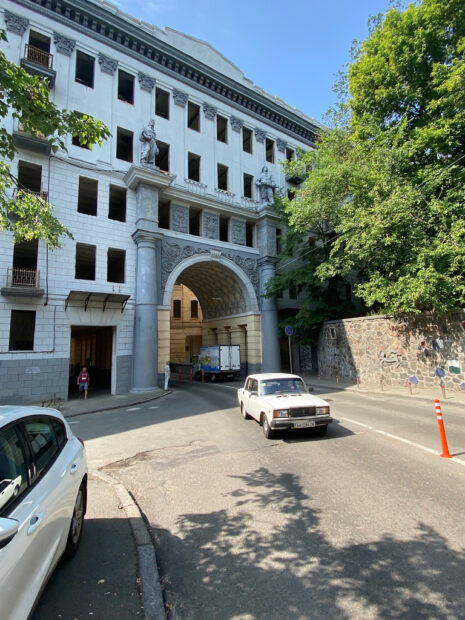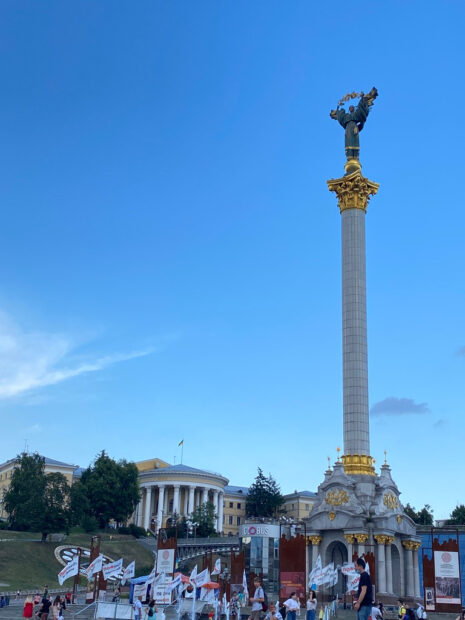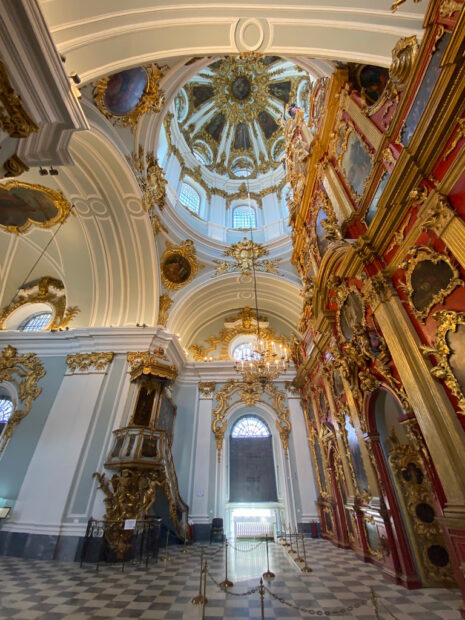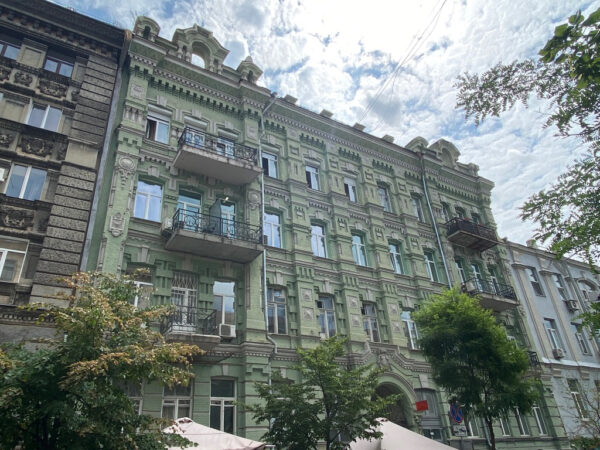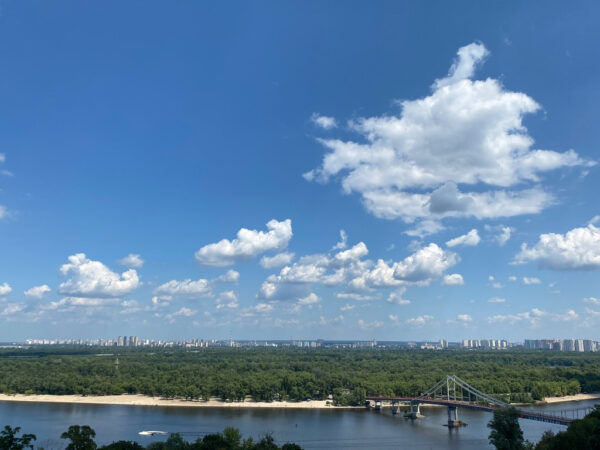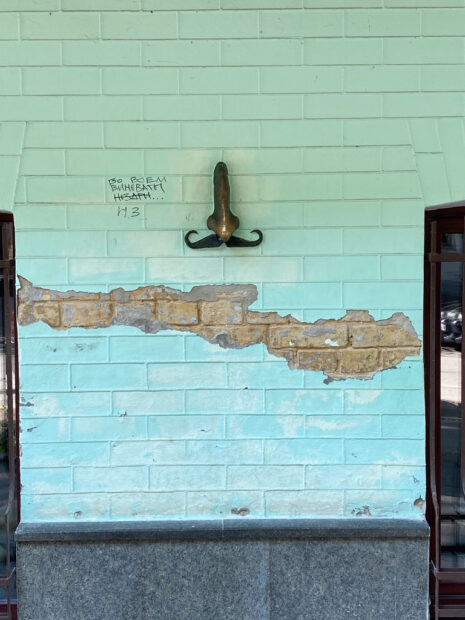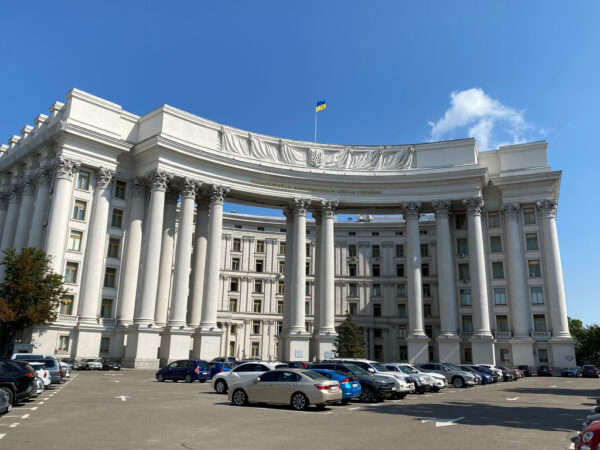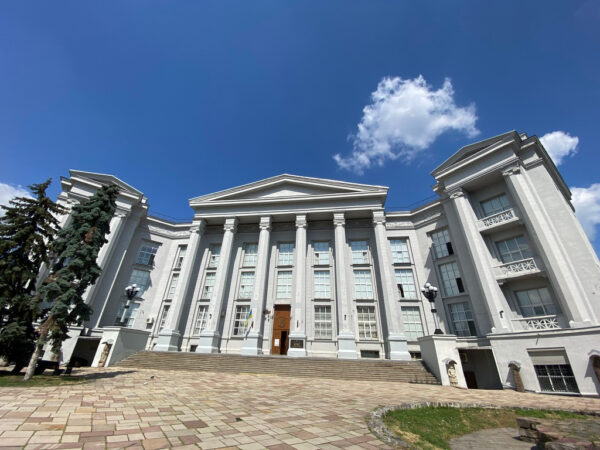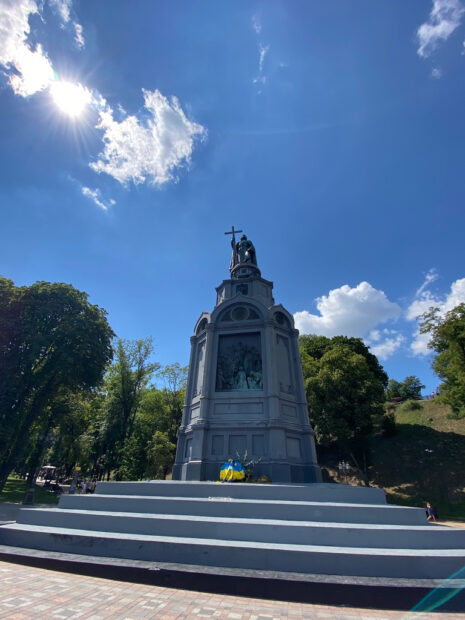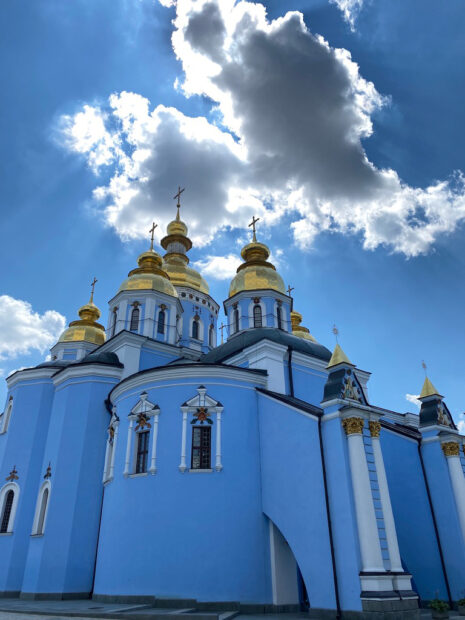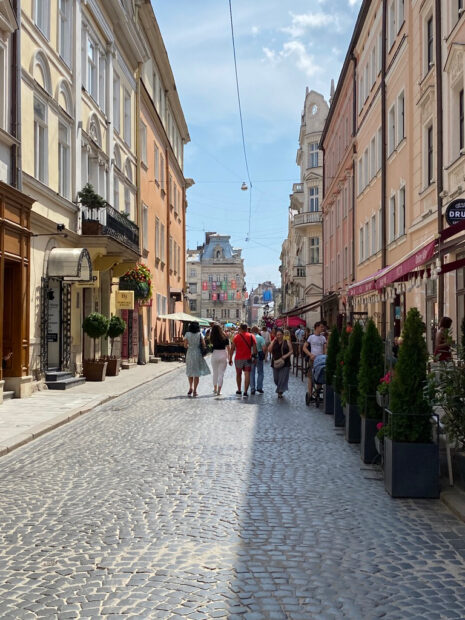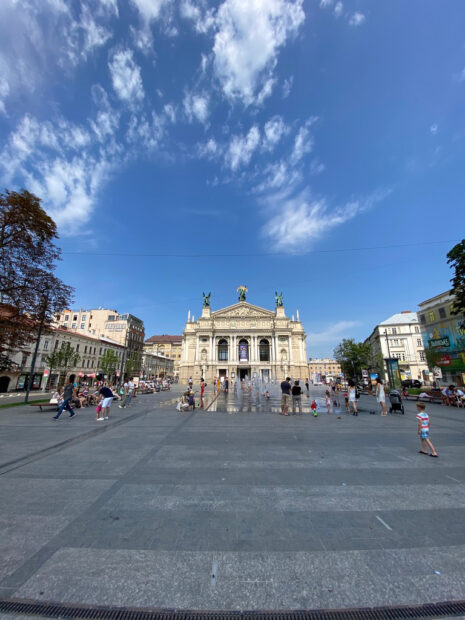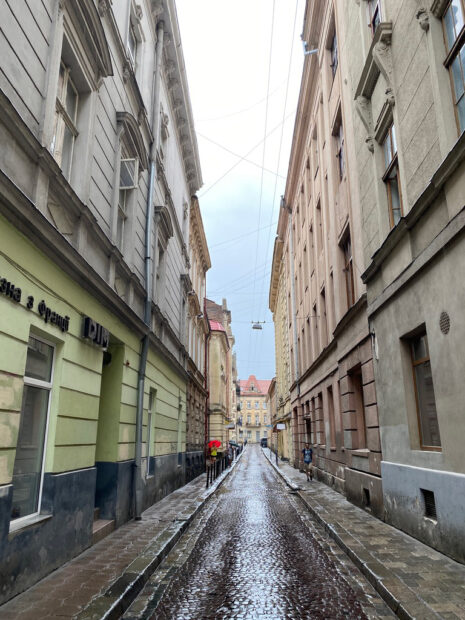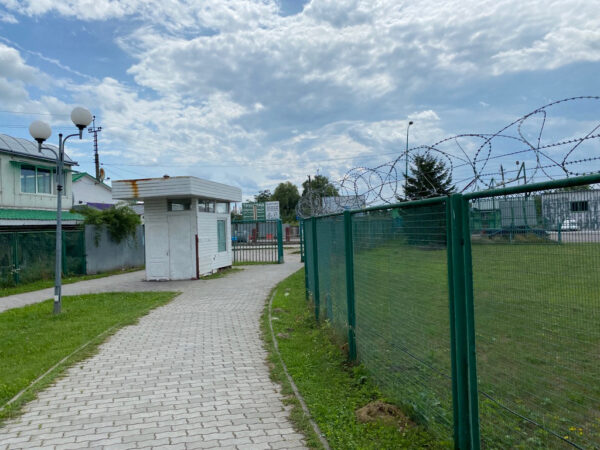To read the previous parts of this series, please go here: Part 1, Part 2, Part 3, Part 4, Part 5.
I love chaos. I love watching the breakdown of systems that eventually turn into systems that somehow work in their not-working. I was raised in a strict Pentecostal home, which meant rules on top of rules with no questions or criticisms. My nearly 20 years in Mexico has made me skeptical of rules, a trait that is often received with a very dramatic eye roll from my mother.
I struggled with this during my time in Estonia. There, rules are not only followed, they are strictly adhered to and communicated, which is all well and fine until you don’t speak the language or know the rules. But when I landed in Kiev, Ukraine’s capital city, I was faced with a wall of chaos that began the moment I stepped on the ground.
The plane landed in the middle of the tarmac and a metal staircase was wheeled over to the door for passengers to descend. On the other side of the tarmac was a tall chain-link fence lined with people waving, shouting, carrying signs, and waiting to receive people coming off the plane. The distance between the plane and the onlookers was only a few meters, and while the reception was lovely, it certainly wouldn’t fly by United States standards.
Perhaps I just hadn’t done enough research, or perhaps my preconceived stereotypes and generalizations had not allowed for a semblance of reality to settle in, but standing there on the tarmac, I felt an overwhelming sense of disbelief of where I was. Suddenly, the sense of comfort in chaos made all of my nervousness disappear. Even with a language barrier (I don’t speak Ukrainian), this was a place I felt I could attempt to understand.
I made my way through immigrations and customs and found a driver in the masses of taxis and rideshares. He was the only person who was neither aggressive nor yelling, and my gut told me that he would get me to my apartment in the city center. During the forty-minute drive, he proceeded to tell me story after story of the city, of all the times it was conquered in its 1,500-year history, and noted how it has been completely destroyed and rebuilt at least four times. According to him, there is actually very little left of what was the original city of Kiev. He wove between narrow streets that were full of pedestrians who were walking, sitting at cafes, and generally living life.
For some reason, in my Western mind I had imagined Kiev and Ukraine as a destitute and defunct land of detritus and poverty, and while the country might be considered the developing country of Europe, it also has a palpable heartbeat. Ancient streets are juxtaposed with Bauhaus architecture; we drove under grand European style monuments and triumphal arches with ornate surfaces; and we passed intricate buildings in a confluence of styles that reflected the crossroads of culture of the city itself. As the streets became more narrow, we passed lime green, pale pink, soft yellow and powder blue buildings until we arrived at Independence Square.
My driver left me at the door of a massive apartment building where I stumbled through check-in with a door person who barely spoke English. Up to that point, my lack of language hadn’t been an issue, and I started to feel silly for worrying about it in the first place. I was already learning that I had underestimated the city greatly, and between this realization and my arriving and being in Ukraine, the emotion was overwhelming and hard to describe. Never in my life had I considered it possible to travel to Kiev — it seemed too distant, too remote from my world. I dropped my bags and went in search of food.
It was already night time when I arrived. At 10 pm, Independence Square was still packed with people gathered in the plaza and enjoying the warm evening. I settled into a French Restaurant just off the plaza that was still open, for what I would later learn was just my first full meal of the night, followed by bratwurst and shawarma. I was hungry, and I neither realized how much I had missed street food, nor that Kiev is one of the best cities for food. In retrospect, I shouldn’t have been so surprised. Inevitably, these places that have faced historical conquest become a middle ground, a convergence of food, customs, and culture. Ukraine is no different.
In many ways, it is the gateway to the West, with the European Union along its border with Poland. It sits on the edge of the Black Sea with cultural influence and immigration from the Republic of Georgia and Turkey, and famously, it defends its eastern border from Russia, a threat that felt distant when I was there, but a threat that has since grown increasingly real once again.
The evening I arrived I wandered through Independence Square, famously named such in 1991 after Ukraine declared itself an independent country amidst fall of the Soviet Union. The place was active and vibrant, and it felt removed from the political mess in which the country had become non-consensually embroiled. Locals were just living life the best way they could, and perhaps that is the mentality of people living in places that are so in-between, chaotic, and volatile — life is lived in the present. That was the mood that surrounded me in Independence Square as I sat on the edge of a fountain eating my third dinner of the night, a shawarma wrapped in foil and paper towels, grease dripping down my chin.
It was in that moment of stillness that I realized the sun had finally started setting — the northern, ever-present daylight was beginning to wane, and nighttime was becoming nighttime again.
I admit I had no plan for my time in Ukraine. My hopes of researching and learning more about Fanny, my paternal great-grandmother, became more of a long shot leading up to the trip. COVID continued to dictate my plans, and my requests to access the city’s archives were ping-ponged between departments, going from the local level to the national, and then back to the municipal level, creating an email chain that was so complex and full of Ukrainian attachments I couldn’t read that it seemed impossible that I’d come away with any real information about my family. I settled on the fact that I would focus on just being: on wandering and learning and taking in the place that was the epicenter of the country that a branch of my family came from.
To say that Kiev is cool is the understatement of my life. It is exciting, bustling, and experimental; no one and nothing looks the same. It is also enormous. There is a character of the city that I’m drawn to because I can’t fully put my finger on it — but it stands out in the tiny details that stick in my memory. The heat wave had reached Kiev in the summer of 2021, and I remember the sound of the dripping air conditioning units protruding from the sides of buildings. I remember the textures, the fact that my eye couldn’t land on a single spot in any architecture because there was so much to see and process. The contrasts of colors against textures was an incredible combination of what my Western mind reads as a Baroque Rococo, an ornateness that gave every part of the city an intensity I had never experienced. The heat of the city stuck with me because I watched passersby walking and enjoying it, dressed in impeccable fashion that mixed contemporary styles with traditional cuts, shapes, embroidery, and fabrics.
I was also struck by the landscape of the city itself. I was surprised by the hills, and learned that Kiev is a city built in layers that start from the top of a cliff overlooking the Dnieper River, then works its way down in layers that were built around the summit— almost like concentric circles. It also is bisected by the Dnieper River, which is the fourth-largest river in Europe and feeds into the Black Sea.
I visited the Pinchuk Art Center, housed in a historical building in a bustling area close to the city center, where a group exhibition was on view featuring artists responding to the tumultuous political era of the 90s. This show was in conversation with an exhibition about architecture in moments of unrest.
I wandered more, ate food, then more food, and traversed the hills up to the National History Museum of Ukraine, which is truly a hallmark of Western museum-making. The Neoclassical structure checked all the boxes of what a history museum should be. The Greek throw-back facade included a clean and unadorned pediment resting atop Ionic columns. An elevation of windows lined the facade, making the main entryway look tiny by comparison. I was relieved when I walked inside and found the museum to be full of beautiful chotchkies; an old watch, a historical ring, a textile someone likely wore more than a hundred years ago. Then, leading into the modern era, the country’s histories are told with text panels printed on foam core.
The story that the museum tells is a story that complicates what we hear in the United States, and indeed it is much more difficult to digest. I still struggle with piecing it together, and given that the information was provided by a state-led institution, I also took it with a healthy dose of skepticism. In these panels, I learned that Ukraine has a dark history of religious, ethnic, and class persecution — a totalitarian regime in the late 1920s that preceded Nazi occupation. Later, throughout WWII, Ukraine was invaded by Hungary with the help of the Third Reich, then terrorized by the Russian army, which fought a war against Nazi Germany. This resulted in more mass executions, deportations, and internment camps that claimed the lives of hundreds of thousands more, if not millions.
The story told in these didactic texts left me with too many questions. Granted, I was reading a translation, and there was little space for a lengthy explanation for something so complicated, but I actually walked away very skeptical of how the story read. Too much was blamed on other countries, class uprising, and the Nazi occupation. The Holocaust was never addressed directly — it was passed over quietly, like a secret being buried in an edited history.
It is remarkable how our collective memory can remain so short.
I stumbled out of the museum back into the sunshine and decided to walk a path along the river back down to Independence Square. I had a lot to grapple with, and I began to think more about my great-grandparents and their parents. I know so little about their family that almost nothing is off the table: it is possible they were Jewish; it is also possible they were born into serfdom; it is also possible they faced immense discrimination for their skin color and poverty in a time when the world was changing.
At some point before arriving in Ukraine, I stumbled across a census in which my great-grandfather described his skin color as “ruddy.” It was a box checked amongst other options, such as “sallow,” “dark,” “light brown,” and “dark brown.” This stuck with me because it bothered me so much. It was not just a skin color, but rather, a skin condition which had been passed down. My grandmother had sensitive skin that was easily irritated , and myself and some of my cousins still suffer from hives if we use harsh detergents or soaps. We are all so connected, but have lived such different lives.
My pull to Kiev hadn’t wavered, in fact it became more profound because my situation was so much more complicated. I trotted down the walkway, past the artisan market, through the dense forest growing on both sides of the path, over to a monument to Prince Volodymyr The Great, and across a massive pedestrian bridge overlooking both sides of the city. The next day I would travel to Lviv, a border town with Poland. I had the ambitious plan of spending a few days there and then walking across to Poland and making my way to the town of Jaroslaw — potentially where my great-grandfather had been born. But I wasn’t ready to leave. Somehow, that city had grown roots in me. It felt like a place of history and myths and fairy tales, a place where there were once dragons and magic.
————
I woke up in Lviv in a panic. My earthquake alert started going off in the middle of the night, saying that there was a large enough quake off the coast of Oaxaca to be concerned. For a second I had no idea where I was, and my earthquake instincts kicked in and I jumped out of bed looking for my shoes. I was at the door of my hotel room when I processed that I was thousands of miles away from the quake. It’s surprising the things that linger and the things we let go of.
My day started slowly after that. Once again, I had no real plan — I just wanted to get a sense of this border city. I have a hard time researching things in advance; nothing seems to stick in my memory unless I have a real place to ground it with. My memory is visual, and I need the gravity of a site to grasp onto, a trait that has become alarming to me as I age. I witnessed the disintegration of the memory of both my paternal grandparents as they struggled with Alzheimer’s. Every lapse in my memory is a trigger, a warning, and waking up slowly that morning in Lviv was a moment of disorientation in my earthquake panic, before I could remember where I actually was. Such an extreme lapse in memory while traveling the place where my family could be from, and trying to piece together the history of my grandmother, who died from complications to her memory, was a surreal thing. But I was in this border town for a reason, and it was unlike any border town I have ever seen.
Lviv is considered the gateway to Europe, and with good reason. It is the last major city in Ukraine before you reach its western border with Poland, the entry point to the European Union. The city was experiencing a major tech boom and — at least on the surface — seemed to be thriving from it. The cranes in the sky indicated growth, and the streets were full of tourists and Ukrainians alike, enjoying the scenic, well organized, clean and ancient city. This land was truly a place of convergence, where migratory patterns and proximities between centuries collided and left their marks. The city was easy, and even its layers of history didn’t require much work to pull back and expose. Lviv is proud of what it is as a historical place in-between — the last stop in the East before crossing into the West — and while the city’s architecture was a reminder of its past, its sense of organization felt more Western than Ukrainian.
Fittingly, Lviv was supposed to be just a stop along my way. I wanted to walk across the border to Poland. I wanted to have a sense of what that crossing felt like, what moving from one side to the other — from East West — meant. My plan was to taxi to the border crossing at Shehyni, walk across to Straz, then taxi into the closest town for the night. From there, I planned on traveling by train to Jaroslaw, spend a few days getting a sense of the place, then make my way to Krakow, then Warsaw, and fly back to Estonia. I gathered all of the necessary documents, filled out my COVID health declaration form, purchased COVID insurance, and set out for my adventure. From the immigration station in Ukraine I was ushered forward, along with a handful of people making the long trek from one side to the other. We weren’t crossing a bridge, exactly — just a sidewalk of paving stones between two green chain-link fences. On one side, just over the fence, was the highway cars used to cross, and on the other side sat a large, lush field. I dragged my luggage across the paving stones and joined the small group of people waiting in line.
I wasn’t quite in Poland yet, but I was definitely on the Polish side, and everything felt different already. I left the immigration office in Ukraine to warm wishes of “goodbye” and “thank you for visiting.” Even in broken English, there was a warmth to the language that disarmed a relatively awkward situation of being lost in translation. Arriving on the Polish side, however, was tense. Those waiting to cross were suddenly talking in hushed voices, if they talked at all. The Polish immigration officers were barking orders simply for their own sake — no one was moving and we all stood in relative stillness waiting our turn.
One by one, we were very slowly called into customs, where a very thorough luggage inspection ensued. Every single item in my suitcase was taken out and systematically strewn across a table by the customs officer who then yelled at me to move out of the way for the next traveler when I tried to methodically fold my belongings back in the suitcase. Somehow, with one arm, I scooped the suitcase and its contents over to another table where I was barked at again for an unknown reason as I proceeded to stuff the contents back into the suitcase, jump onto the table, and sit on top of the suitcase to close it. At that point I had been yelled at by every officer in the room for taking so much time to repack the suitcase that had taken them mere seconds to empty.
At this point, I was the only English speaker in the entire office. I was pushed into the immigration line and proceeded forward to the window when an officer called for me with a wave of their hand, accompanied by a brash utterance. I didn’t understand the officers’ words, but the tension was thick and the frazzlement of my fellow travelers was palpably growing.
I handed my papers over to the immigration officer who proceeded to ask questions I didn’t understand. I stared at her like a deer in headlights, and managed to perceive the details of her thick makeup — the blush that was applied in circles and flaking off the dry skin of her cheekbones, and the eyeliner drawn heavily across her eyelids that was cracked and spotty. As she yelled at me, she played with her blonde-from-a-box hair that was braided thickly and tied high enough that long split ends straggled out. According to my research, I had all the documents necessary to cross, and my status as a U.S. citizen offered open entry to any Schengen countries — countries that are a part of the European Union. But I continued to stand there as the officer simply raised her voice, escalating the situation as I desperately sought a way to communicate.
That’s when a good samaritan with a basic knowledge of English stepped in and told me that I needed to present a COVID vaccine passport, something that was only offered to citizens of the European Union at the time. The immigration officer would have known I couldn’t possibly have this, because she was holding my U.S. passport in her right hand, and my vaccine card in her left as she continued to scream at me.
Something in my gut told me that the officer wasn’t just yelling to try to communicate; it hinted that she was screaming both obscenities and insults at me. At that moment, she threw my documents back at me. I calmly grabbed them, turned around, and started walking back to Ukraine. I had no other option.
In that long walk back between Poland and Ukraine, every possible scenario went through my head. If the issue was a COVID passport, how could I get back into Europe, because essentially what just happened was that I was denied re-entry into the European Union. According to my research, vaccinated persons were able to cross borders freely, and some just needed additional insurance to cover medical costs in the case of hospitalization. Fair, easy in fact. I had all of those things and was denied re-entry, so the only thing I could think to do was go back to where I had come from, my hotel in Lviv.
I went through immigration once again in Ukraine, and was greeted with “welcome back” and laughter. The Ukrainian officers’ confusion was as great as mine. I exited to a street with almost no pedestrian traffic and saw a circle of chauffeurs smoking cigarettes on a nearby corner. I took a deep breath and in very slow English asked for a taxi back to Lviv. I was ushered into a car and prayed a silent prayer for nothing but the best.
We turned the corner onto the street of my hotel about an hour later; I’ve never been so relieved to see a familiar street. I had run through all the backup plans in my head. As soon as I got settled, I planned to purchase a flight directly to Warsaw, to skip the middle stuff of Jaroslaw and Krakow, and get myself back into the European Union. If the second attempt didn’t work, then I would contact the U.S. Embassy and settle into Ukraine until it all worked out and I could leave again.
Another hour later I was sitting at the hotel bar with a boarding pass to Warsaw on my phone and a vodka soda in front of me. It would be the first of a few to aid my mental and emotional preparation for what was to come the next day.
All photos by Leslie Moody Castro.
****
Special thanks to Tiiu Vitsut, Filipp Mustonen, The Office of Public Affairs at the U.S. Embassy, Tallinn, Ann Mirjam Vaikla, and the NART Narva Artist Residency. Thank you to Yuliya Lanina for openly sharing your story, and Dorota Biczel for clarifying so much for me so openly. Thank you to my cousins Carol Franco, Brian Nagurny and his father John Nagurny, Aunt JoAnn Villarreal, Aunt Jeannie Cisneros, and Aunt Betty Moody Winters.


